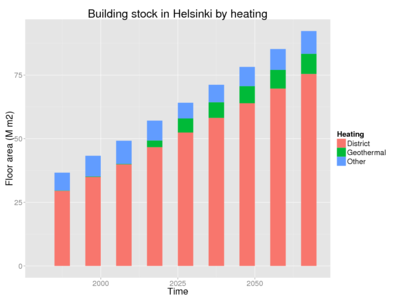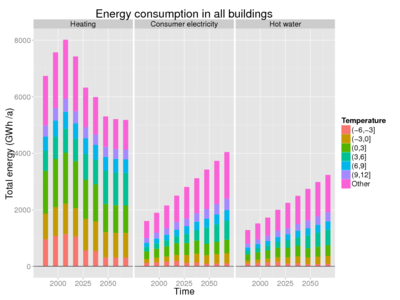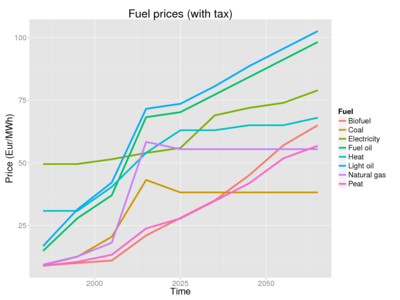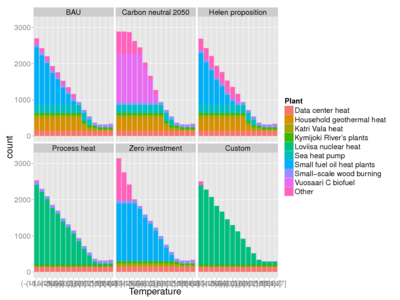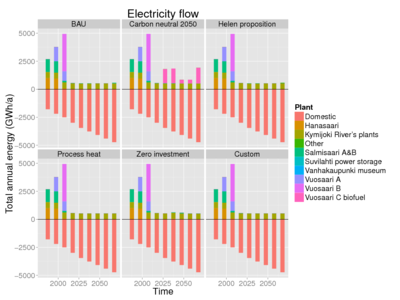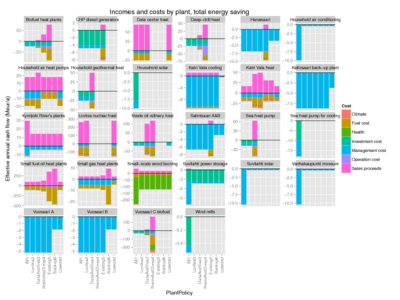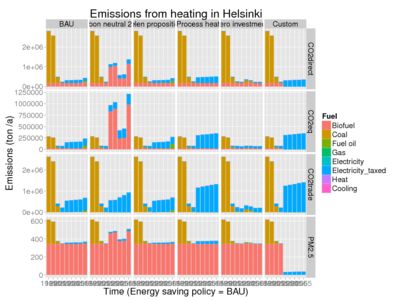Results for Helsinki energy decision 2015
| Moderator:Nobody (see all) Click here to sign up. |
|
|
| Upload data
|
Contents
Scope
What are the more accurate results for Helsinki energy decision 2015?
Answer
Scenarios examined
We examined two different sets of scenarios. The first set was a collection of suggested policies that were interesting to examine for the decision making. The second set was more technical, and it aimed to find the differences in the cost-efficieency of different power plant solutions rather than actual feasible solutions. The sets were as follows:
Suggested policies
- Business as usual (BAU)
- The already existing power plants are renovated to burn biofuels and will remain in use as long as possible.
- Process heat
- As much of the excess eat from different processes will be taken into use. The most important heat sources are the Neste oil refinery in Porvoo and the nuclear power plant possibly built in Loviisa that produces CHP.
- Helen's proposition
- The suggestion of Helen brought out in June 2015. New biofuelled heat plants are built and CHP is slowly given up.
- Zero investment
- As little new construction is carried out as possible.
- Carbon neutral 2050
- All fossil fuels are given up by 2050 and are replaced by biofuels and process heat.
- CHP bio
- Electricity and heat are co-produced in especially the new Vuosaari C -bio-CHP-plant.
- Distributed and sea
- Heat is produced with distributed geothermal, heat pumps and bigger heat pump plants taking heat from the sea as possible.
The technical scenario set includes all existing and suggested new power plants. They are then inspected scenario to scenario in a rough order of cost-efficiency, beginning from the best. In the next scenario then shows which remaining plants will be run to optimise cost-efficiency.
- All1
- All plants are in use.
- Loviisa2
- District heating is mainly produced in the nuclear heat plant in Loviisa. This is when the small and insignificant plants are shut down, so they're not confusing the interpretation of further analysis.
- DataAndSea3
- District heating is mostly produced from excess heat from data centers and with sea heat pumps. Loviisa nuclear heat is not taken into use.
- NesteAndDeep4
- District heating is mostly produced from excess heat from Neste, in Viosaari C power plant and with deep drilling. The data center heat and sea heat pumps are not used.
- Existing5
- District heating is mostly produced with the existing plants, meaning Hanasaari, Salmisaari and Vuosaari CHP plants. Vuosaari C is not built.
- Backup6
- Disrtict heating is mostly produced in the back-up oil and gas heat plants.
- Lowcost
- Only the most cost-effective plants from the previous scenarios are run. This means Loviisa nuclear plant, data centers' and Neste's excess heat, Katri Vala heat pumps and the small back-up oil heat plants.
Building stock development and other background information
The increase in the number of buildings is more or less what the zoning scheme predicts the population and building stock to be, meaning an increase of 42% from 2010 to 2050. This looks greater in the image, because the buildings already demolished are seen as never existed, and this makes the historical growth seem greater that it in truth is. The time period also goes on far further than 2050 and the increase is assumed to remain stable also after that.
The energy use of buildings is the single greatest user of energy in Helsinki, and this is why it is especially important to examine. The increase in building stock also increases the energy need, but according to the model the need doesn't increase or even decreases by a fifth. There are two main reasons for this. First of all, the new buildings are assumed to be very energy efficient, so the increase in the energy consumption is smaller than the increase in building stock would indicate. Also, old buildings are renovated, which increases energy efficiency and decreases the energy need of current building stock. However, the full energy efficiency policy (Energy saving total) is quite radical, so the decreased energy consumption in the model is very difficult to achieve. The only real way to do this would be to demolish the oldest, most inefficient part of the building stock and to replace it with new, highly efficient buildings. This is not something assumed in the model.
The prices of the fuels are key background information. The price difference is often the deciding factor in which plants are run and which are not. Any long-term forecasts of fuel prices are bound to be difficult. We have dug up respectable estimates from the International Energy Association (IEA), but the uncertainties are still great. Their estimates assume the price of natural gas to increase more rapidly than the price of other fuels. This leads to the gas plants Vuosaari A and B and smaller gas heat plants seem to have low cost-effectiveness, and thus should not be run. This should be kept in mind when interpreting the results.
Energy production
Behind the model is the energy balance calculated for district heating. The production of district heat has to match the current consumption, whether it's heat or freezing outside. The model calculates the energy need and production for different days based of the outside temperature and finds the required plants for the situation. Every plant has a maximum capacity that can't be crossed in the model. So the most cost-effective plant runs with full power. If more energy is needed, the second most efficient plant is turned on, and so on. This daily information is summed up for the whole year, so the situation can be examined over decades. It is good to notice that very high power requirements are rare, so a big portion of the power plant capacity stays idle for long periods of time.
Electricity was examined in this assessment only as a convenient side product, but it also plays an important role. Sofia assumes that electricity can be bought and sold in the national network without limits with a fixed price. We were supposed to add a part to the model that takes into account the changes in electricity prices, but there wasn't enough time to finish it. Either way it is important to examine the different options' effect on the electricity needs in Helsinki. In previous years and currently Helsinki produces more electricity than consumes, and selling electricity is actually good business or the city. This is because of efficient CHP-production that has been the basis of district heating in Finland in the past few decades.
However, many of the new options examined are ones that might not produce any electricity and might actually consume it quite a lot. So if the current coal and gas plants are run down there will be an electricity deficit in Helsinki, that needs to be filled from the national network one way or another. Practically this means the Nordpool area that also include Sweden, Norway and Denmark.
Expenses
Sofia regulates the use rate of the plants according to which plant has the lowest fuel and usage expenses. However, there are also other expenses that aren't taken into account here but shouldn't be forgotten. A power plant requires investment and upkeep expenses, and there will be external expenses that aren't directly paid by whoever maintains the plant. Carbondioxide emissions cause environmental problems and particulate matter affects health. Also these expenses have been taken into account and thus added to the total costs of the plants.
The total cost is calculated for the duration of the plant's entire life cycle, and they are then put into perspective so that we can talk about calculated yearly cost, even though the expenses of some options come from the beginning investments, and other's come from high usage expenses. These calculated yearly costs are compared to the energy produced by the power plants during their life cycle, and thus it's possible to compare the cost-efficiency of the plants.
The most cost-effective options seems to be Loviisa's nuclear heat, the excess heat from data centers and Katri Vala heat pump plant (which is more cost-effective, since it already exists). The current plants in Hanasaari, Salmisaari and Vuosaari are left behind in the assessment. This is probably due to estimates of coal and especially gas prices rising significantly in the following years. Never the less, it's worth remembering that the cost estimates are very uncertain, and they mostly tell which options are the most interesting for future assessments. These results should not be considered straight as decision recommendations.
Health and environmental impacts
The health problems are a relatively big cost maybe surprisingly in only one option: if separate houses are in the future heated with their own furnaces and ovens. All the big plants have small health impacts and Sofia doesn't see health as a factor distinguishing between better and worse options. This is obviously geed new regarding health.
The environmental impact was calculated with a higher cost than the current emission trade cost. It was set at 45 €/ton of carbondioxide emissions, including some uncertainty as to how to count the CO2 emissions. Nowadays the cost of a carbondioxide ton in the emission markets is significantly less than ten dollars, though probably everyone agrees that the problem is in the emission trade rules and that the current price doesn't meet the actual external expenses.
Even with 45 euros per ton the environmental impact seemed surprisingly very small. Even so the result seems legit, because even though the price sounds high, it's only 1.5 €/MWh, while the prices of fuels are over 40 €/MWH. Compared to this the environmental cost is marginal. It would be interesting to get comments from experts about what the real external cost is and how it should be calculated.
One surprising observation was that even though all fossil energy production was given up in Helsinki, the emissions could still be high. This was due to the fact that many new solutions were based on buying electricity and producing heat with processes, that on their own were efficient. However, if the bought electricity is produced with fossil fuels somewhere else, it doesn't remove the problem, only relocates it.
Rationale
Links to model runs
- Basic model run, that calculates the size and energy need for the entire building stock. These results are saved and used later in scenario examination run 6.9.2015.
- A model run which Custom chosen by the user is the same as the Lowcost for the technical scenario set. This means Loviisa nuclear heat, data center and Neste excess heat, Katri Vala heat pumps and as back-up the small oil heat plants. run 9.9.2015, newer 9.9.2015 at 14:00
- A model run that was used to look for the most cost-effective options, compare plants and define the Lowcost scenario run 9.9.2015
See also
References
